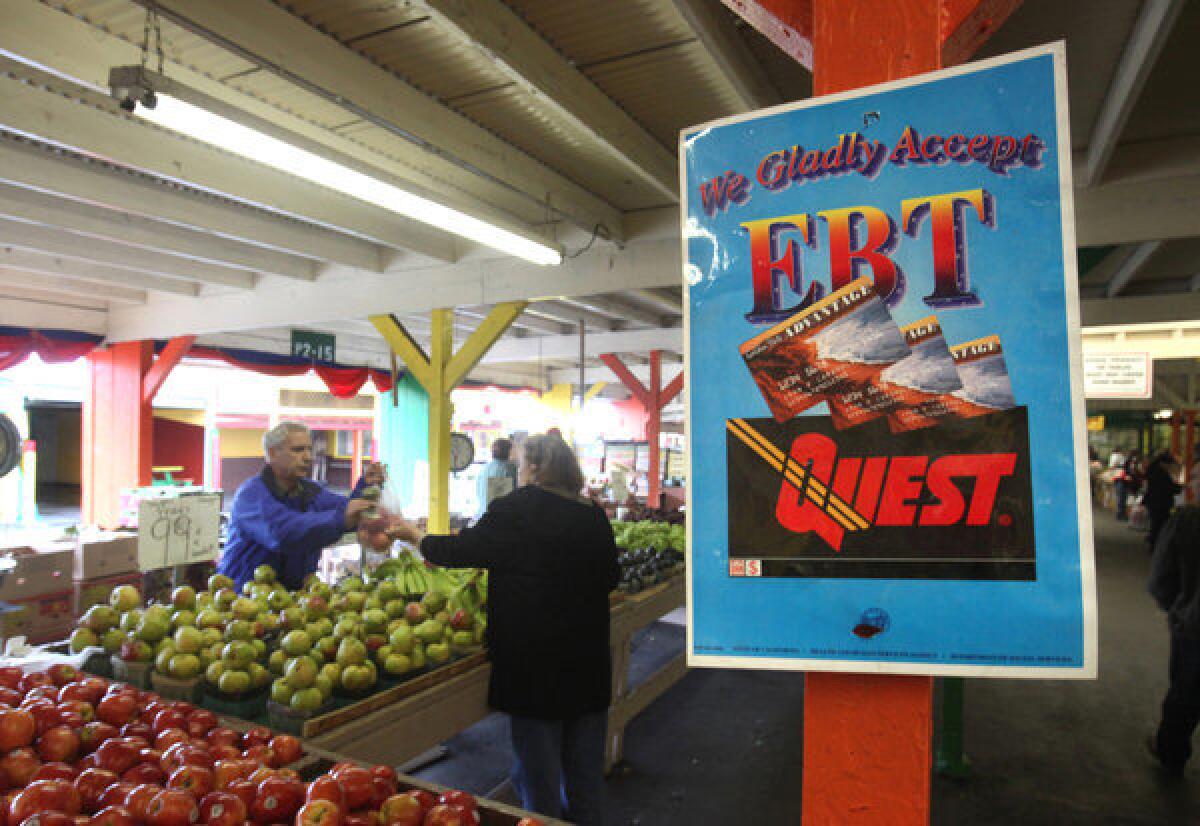Some ugly misconceptions about food stamps

It’s back to the drawing board as Congress voted against its farm bill Thursday in an unexpected defeat for legislation relied upon to set U.S. food policy. Some conservative Republicans thought the bill didn’t curtail enough spending, while many Democrats opposed it because of cuts to the food stamp program. As The Times wrote in an editorial, those draconian cuts would have hurt struggling families and undermined a program that expands during down economies because hungry Americans need it to.
Before the bill failed, Rep. Michael K. Conaway (R-Texas) was already making provisions for the possibility that political ineptitude would save poor people from getting kicked off the food stamp rolls. He proposed an amendment threatening that if a farm bill wasn’t enacted by Sept. 30, across-the-board food stamp cuts would go into effect that would dock $64 per month from the average recipient.
That amendment won’t do any damage now that the bill is dead, but the fact that a lawmaker would offer up low-income people’s meals as insurance against congressional gridlock presents us with another opportunity to examine false accusations against the food stamp program. Lately, it’s been brandished as an archetype for government abuse that sinks lazy people deeper into dependency. What’s the real story? Here are three misconceptions about food stamps, and some evidence that they aren’t instruments of reckless government waste.
Misconception No. 1: Hipsters are stealing government money to finance a fresh asparagus fixation.
“They’re young, they’re broke, and they pay for organic salmon with government subsidies,” Salon’s Jennifer Bleyer wrote in an article highlighting hipsters’ place on growing food stamp rolls. A Wall Street Journal op-ed similarly charged the government with letting rich people get richer off food stamps. Obama’s lax food stamp policies “permit Trust Fund Babies driving Rolls Royces to get free food courtesy of Uncle Sam,” James Bovard wrote.
It’s true that juicy and disturbing anecdotes linger out there about lottery winners collecting food stamp funds. (A farm bill provision would have eliminated this loophole separately from broader cuts.) And people are right to be upset that so many of the low-wage jobs regained during the recovery still leave people hungry.
But the idea that food stamps are funding artisinal bread binges for trust fund babies is flat-out false. More than 90% of food stamp benefits go to households below the poverty line ($23,550 for a family of four). Two in five households that receive benefits have incomes below half the poverty line. And the overwhelming majority of beneficiaries are poor families with children, seniors or people with disabilities. These aren’t Rolls Royce drivers. They’re people somewhere on the range between vulnerable and completely destitute.
The notion that food stamp recipients are living off the government is another ugly fiction. Only 8% of households that receive food stamps are on welfare. And a majority of people who receive food stamps and are able to work, in fact, do so.
Misconception No. 2: People get fat off food stamps.
When Rick Santorum in 2011 proposed significantly cutting food stamps, he expressed confusion at how hunger and obesity could coexist. “If hunger is a problem in America, then why do we have an obesity problem among the people who we say have a hunger problem?” Santorum asked.
The first lie is Santorum’s suggestion that people use government funds to satisfy unhealthy food cravings, driving up obesity rates and healthcare costs. In fact, food stamp recipients spend more than 85% of their benefits on fruits and vegetables, grains, dairy, meat and meat alternatives. Whatever money gets spent on fast food probably has more to do with the fact that low-wage families face extra pressure finding time to shop and cook than other families, not the extravagance of their handouts.
The second lie is that anyone could possibly get fat off an average benefit of $1.48 per meal. On the contrary. An Institute of Medicine/National Research Council report showed that food stamp benefits don’t adequately feed most Americans struggling with hunger.
Misconception No. 3: Food stamps make us a nation of takers.
“The more people who become government dependents, the more likely that democracy will become a conspiracy against self-reliance,” the Wall Street Journal warned in its op-ed on food stamps.
People below the poverty line probably won’t have the power to promote a large-scale conspiracy against self-reliance any time soon. But even if they were interested in such a takeover, it turns out food stamps wouldn’t help their pro-dependency cause.
The number of households that work while on food stamps has tripled in recent years – from 2 million in 2000 to more than 6 million in 2011. That trend raises concerns about under-employed families who still don’t make enough to eat, but it doesn’t suggest that they’re lazy.
Second, the food stamp program isn’t designed for long-term dependency. Most unemployed, childless adults on food stamps are allowed only three months of benefits (though that limit can be overridden in areas of high unemployment). Food stamps are meant to get people through hard times, not hook them on government aid.
Finally, a recent study from UC Davis shows that food stamps actually promote self-sufficiency. The study found that women who had access to food stamps as children grew up to be more self-reliant than those who didn’t. They reported improved employment, income, poverty status and high school graduation. Nourished people, it turns out, are more productive people.
So why do so many lawmakers get food stamps so wrong? Part of the problem might be that among all the House hearings on the farm bill, not a single one focused on hunger. Americans are starving and some lawmakers aren’t paying enough attention.
ALSO:
Russia’s family values experiment
UC and Native Americans: Unsettled remains
Twitter: @benjmueller
More to Read
A cure for the common opinion
Get thought-provoking perspectives with our weekly newsletter.
You may occasionally receive promotional content from the Los Angeles Times.






